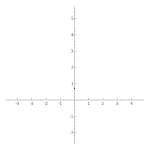Butterfly curve (transcendental)
The butterfly curve is a transcendental plane curve discovered by Temple H. Fay of University of Southern Mississippi in 1989.[1]

Equation

The curve is given by the following parametric equations:[2]
or by the following polar equation:
The sin term has been added for purely aesthetic reasons.[1]
Developments
In 2006, two mathematicians using Mathematica analyzed the function, and found variants where leafs, flowers or other insects became apparent.[3]
See also
- Butterfly curve (algebraic)
- Oscar’s Butterfly Polar Equation
r= (cos50)^2 + sin30 + .3 A Polar equation discovered by Oscar Ramirez a UCLA student in the fall of 1991. https://books.google.com/books?id=laXgAAAAMAAJ&q=Oscar%27s+Butterfly+polar+math+equation+by+David+Cohen+inauthor:David+inauthor:Cohen&dq=Oscar%27s+Butterfly+polar+math+equation+by+David+Cohen+inauthor:David+inauthor:Cohen&hl=en&sa=X&ved=2ahUKEwjf1bPwqJ3uAhVKJzQIHTvUDfMQ6AEwAHoECAAQAg
References
- Fay, Temple H. (May 1989). "The Butterfly Curve". Amer. Math. Monthly. 96 (5): 442–443. doi:10.2307/2325155. JSTOR 2325155.
- Weisstein, Eric W. "Butterfly Curve". MathWorld.
- "On the analysis and construction of the butterfly curve using Mathematica". International Journal of Mathematical Education in Science and Technology. 39 (5): 670–678. June 2008. doi:10.1080/00207390801923240.